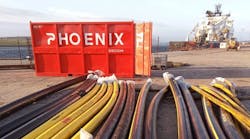A tool to utilize the virtual reality (VR) environment for quality control of ongoing seismic acquisition operations has been developed by PGS (Petroleum Geo-Services). The technology offers visualization in combination with fast inspection of large data volumes.
There are several different types of VR systems on the market today. PGS uses a dual-screen Holobench system from TAN Pro- jektionstechnologie, which provides users with a reasonable degree of immersion while the physical size of the installation is limited. Up to six people can work together in front of the Holobench, and the users interact directly with the data through a wand (3D mouse used to point and click in the virtual environment). The firm's visualization software, holoSeistrademark, has been designed to provide stereographic volume visualization and can handle very large data volumes.
To utilize all the capabilities of holoSeis, a simple model of the subsurface geology in the acquisition area should be established. A typical scenario is to build this model based on existing 2D data. Although the initial model generated in this way may be too coarse, the model can be updated based on new data from the ongoing acquisition. Experience has shown that 100% correctness of the model is not critical.
The navigation data from each sail line is processed onboard the vessel and subsequently transmitted once every night via a satellite link to the onshore processing center. Seismic data is routinely processed onboard all 3D vessels and this data is also transmitted onshore on a regular basis via a satellite link. Typically, the onboard processed seismic data consist of near offset cubes, offset limited stacks, or full stack cubes.
Establishing model
Based on the processed navigation data and the 3D subsurface model, the seismic acquisition is simulated using dynamic ray tracing. The raytracer supports arbitrary complex models and is fast enough to model all sail lines acquired during a 24-hour cycle within 4 hours. Based on the raytracing, a number of different horizon based attributes are generated. The most commonly used are minimum offset, maximum offset, offset distribution, reflection point coverage and azimuth distribution. The entire process is so fast that data received during the night can be analyzed during the afternoon the following day.
In the rare case that no a priori information is available, acquisition may have to start without any model of the subsurface. During the course of the acquisition, in most cases, some key horizons can be quickly interpreted, either on a near offset cube or a stack cube, and used to generate a model required for raytracing and horizon-based attribute analysis.
Analysis of data
The different information can be simultaneously viewed in a collaborative environment. The default view is three orthogonal planes from the seismic data.
Stereo viewing is important. As it is difficult to generate a hardcopy of a stereo image, some of the depth understanding gained by stereo viewing is not captured by these figures. The Midgard West survey is a geologically complex area and the advantage of volume visualizing an entire survey is obvious.
One immediately gains an understanding of how the geology influences the subsurface coverage with stereo. Coverage maps are normally obtained based on surface coverage (assuming a flat earth). The traditional surface-based coverage to the actual horizon-based coverage, here illustrated by the Midgard West data.
The VR environment is an ideal environment for QC of an ongoing seismic acquisition project. VR QC systems let the user analyze large amounts of data in a very short time. The possibility of directly comparing horizon based coverage and illumination attributes with the seismic data offers the possibility of making decisions regarding marginal weather situations, noise and interference, as well as infill.
Acknowledgements
Even Andersen and Øyvind Syljuasen helped develop this system.



